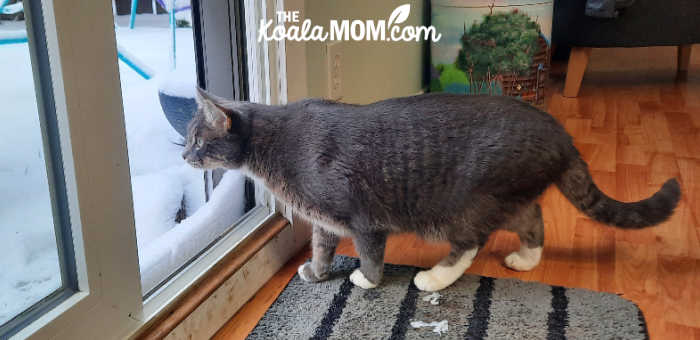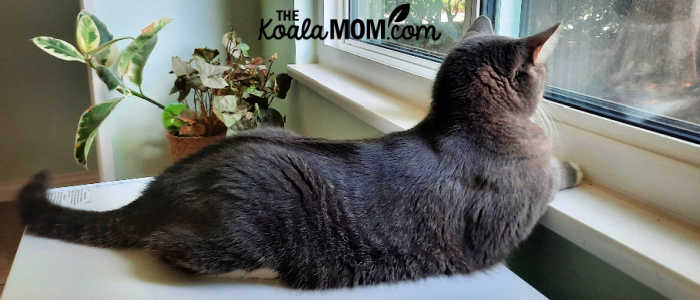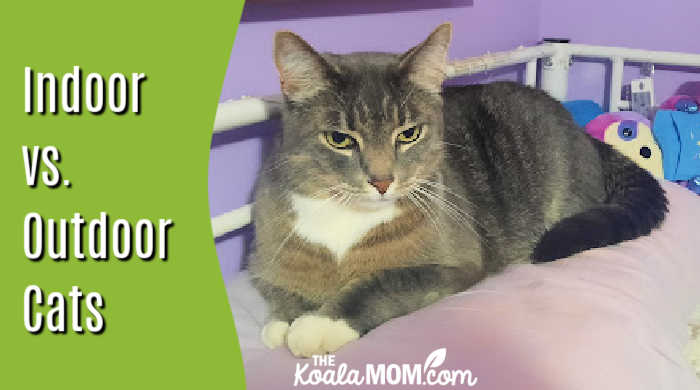Once of the first questions my vet asked me when I took my 8-week old kitten for a checkup was whether he was an indoor or outdoor cat. I hadn’t really thought about the question but figured Jude could be an indoor cat. The vet nodded, although he advised me he’d also thought his cat would be an indoor cat–until the summer his cat was regularly found hanging off the screen door.
Jude remained an indoor cat for the first year of his life and then, despite me advising him that there was a busy street right outside our door and big raccoons in the backyard, he wanted to be able to go outdoors. I let him outside with great fear and trembling for the first few times, worried he wouldn’t find his way home or would get roughed up by someone’s dog. Now, he sits at the door when he wants us to let him in or out, and he hasn’t had any accidents or problems with his outdoor ramblings.
This is a decision each cat owner must make. Outdoor roaming has many benefits, but it is not always safe, and your furry companion can get lost. However, if your cat is like my cat and really wants to go outside, it’s hard to keep them inside. To at least prevent them from getting lost, you can buy a GPS tracker for cat and know your cat’s location anytime. Let’s explore the pros and cons of both options further to make the right decision.
![]()
This post contains affiliate links; as an Amazon associate, I earn from qualifying purchases.
Why Is It Worth Keeping Your Kitty Indoors?
The world is full of dangers, and there are plenty of things your kitty would not like to face under any conditions. Depending on where you live, heavy traffic can be a serious threat for your pet. Fences will not not keep your cat off busy roads; my cat regularly scales our 4-foot high fence. While we’ve always lived within two blocks or less of a busy road, my cat does seem to avoid that road and instead roams in the other direction (through all the backyards).
There are also numerous predators outdoors that could catch your cat unawares; we regularly see coyotes, raccoons, skunks, eagles, owls, and more around our neighborhood. Then there’s other pets whom your cat may disagree with. I worry Jude is rather the king of the neighborhood and bosses the other cats around (as well as the squirrels), but so far he seems to have avoided meeting any of the local dogs.

Furthermore, you should be ready to deal with fleas and contagious diseases your furry friend can get from other animals outdoors. If your cat is a mouser, he may end up with worms. Your cat will need to see the vet more often for preventative vaccines and medications. Having just deal with fleas on our cat, I can say that prevention is a big must!
However, many cats are still full of energy and the desire to move. If you do want them to be indoor cats, you can try to buy interactive toys and climbing structures to keep them busy. Make sure to find time every day to play with your furry friend. It may help to have two cats rather than just one, so that your cats can play with each other and keep themselves entertained together.
The Freedom of Outdoor Cats
Many consider living outside a highly beneficial option for a kitty. Indeed, your cat can enjoy unlimited exercising (particularly if there are fast squirrels in your area), mental stimulation, and the development of natural hunting instincts (mine is a great mouser).
If you do intend to allow your cat outside, it’s a good idea to have your vet give your cat either an ID microchip or an ID tattoo. Jude has a tattoo inside his ear so if he does get lost, hopefully a vet or the SPCA can help him find us again.

I also got a collar for him, with his name and my phone number on a nice little tag, along with a bell to warn off any birds he might try to chase, but he lost that. Then he lost the second collar and bell I got him, so I haven’t tried to replace them. If your cat is less prone to losing collars, it’s a good idea for him to wear one.
Train Your Cat Young
Whichever option you choose for your cat, it’s a good idea to make this decision while your cat is young. My cousin advised me to start training Jude as a kitten to do whatever I wanted him to do as an adult cat. For example, if you want to leash-train your cat or take your cat out in a pet backpack, you need to start this with your kitten. I made the mistake of not getting a good kitty carrier immediately and taking him for car rides regularly, and now he hates car rides. (He huddles in the carrier and howls at us. It’s stressful.)
Jude has proven to be well-trained in other areas, however. For example, I regularly call him when I’m prepping supper and have treats for him, like tuna water from a can of tuna or a small scrap of chicken fat from a pack of chicken thighs. He knows to come running when I call him because he gets treats. So when he’s outside and it’s getting dark, I can often stick my head out the door and call, “Jude! Here, kitty kitty!” and he comes running home. I then give him a couple treats for coming when called. I have peace of mind knowing that he’s usually in shouting distance and usually comes when I call, and he gets some freedom and lots of treats.

Still, Which Option to Choose?
As both my vet and I found, our cats had their own ideas about whether to be indoor or outdoor cats. Perhaps your cat also has an obvious preference. If so, it’s pretty hard to argue with them about it. What you can do is think about alternatives and how to make outings secure and safe. A GPS tracker can help you monitor your cat’s ramblings and find her quickly if she does escape. For pet owners who want extra peace of mind, devices like Petloc8 offer reliable GPS tracking, perfect for keeping tabs on your furry adventurer, no matter where curiosity takes them.
Does your cat prefer being indoors or out? Have you trained him to do anything special?

No Responses Yet